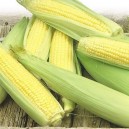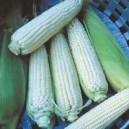
Welcome, Log in
Product Categories
-
Heirloom & OP Seed
- Cool Weather Crops
- Warm Weather Crops
- Beans
- Beetroot
- Brassicas
- Carrots
- Chard
- Corn/Maize
- Cucumbers
- Eggplant (Aubergine)
- Leeks
- Lettuce
- Melons
- Okra
- Onions
- Parsnips
- Peas
- Peppers & Chillies
- Radish
- Spinach
- Squash & Pumpkins
- Tomatoes
- Turnips
- Unusual / Exotic
- Herbs & Spices
- Fruits & Berries
- Value Packs
- View All Seed
- Gift Vouchers
Corn/MaizeThere are 2 products.
Please scroll down or click here to view the product list
GROWING INSTRUCTIONS FOR CORN
Binomial Name: Zea mays
Varieties: Rainbow Inca, Golden Bantam, Strawberry Popcorn, Popi Hopi, Stowells Evergreen
Start: Direct seed
Germination: 7- 10 days, 15°C to 29°C
Seed Life (viability): 4 - 6 years
Soil: Well drained, high fertility
Sunlight: Full sun
Sow Seeds: 3 - 5cm deep with 8cm between seeds in rows 45 - 60cm apart
Transplant/Thin to: 20 - 30cm apart
Ave. Days to Harvest: 75 - 120
Good Companions: Amaranth, beans, eggplant, cucumber, dill, globe artichoke, lettuce, squash, melons, parsnip, peas, petunia, potato, radish, sunflower
Bad Companions: Beetroot, celery, tomato
Corn demands fertile soil, consistent moisture and warm weather. If you have those and plenty of garden space to spare, it’s not hard to grow great-tasting corn and you won’t get it any fresher.
Sowing & Planting: Corn requires rich, fertile soil. Add compost or well rotted manure in autumn. Consider planting a legume cover crop the season before corn to help meet the nutrient needs of this heavy feeder. Make first planting after last frost date. Soil should be at least 18°C for fast germination (corn will not germinate if soil temperature is less than 12°C). To speed increase in soil temperature, consider covering soil with black plastic for several weeks before planting.
Plant in blocks of at least 4 rows (as opposed to fewer, longer rows) for good pollination and well-filled ears. Plant seeds 3 - 5cm deep with 8cm between seeds in rows 45 - 60cm apart. Thin to 20 - 30cm spacings when plants are 10 to 15cm tall. Increase seeding rates to ensure a good stand if soils are cold.
For a sequential harvest, make first planting using an early variety. Two weeks later plant another block of an early variety, plus blocks of mid- and late-season varieties. Continue making plantings until early to mid-summer, depending on the length of your growing season.
Growing: Corn plants have many roots close to the surface so cultivate around them with care. You can hill soil up around the base of plants as they grow to bury small weeds in the row and give the corn a better foothold.
After the soil has warmed you can mulch corn to help suppress weeds and retain moisture. It is not necessary to remove suckers (side sprouts growing from the base of the plant). Studies show that removing them may actually reduce yields.
Corn is a heavy feeder - particularly of nitrogen - and may require several sidedressings of fertilizer for best yields. Look for signs of nutrient deficiency. Purple-tinged leaves are a sign of phosphorus deficiency. Pale green leaves are a sign of nitrogen deficiency.
For miniature or baby corn, plant seeds 10 - 20cm apart and harvest as silks emerge from the ear or harvest secondary ears from normally spaced plantings, allowing the main ear to fully mature.
Harvesting: Of all the vegetables grown, corn is the one most often harvested too late. With corn, it is essential to pick it at the right time to get the best quality and flavor. Corn also starts to lose its quality quickly after it is harvested.
Within 24 hours after being picked most corn loses more than half its natural sugars by converting them to starch. Ideally, you should harvest your corn at the time you are ready to cook it.
Check sweet corn for ripeness when the the silks have turned brown but are still damp to the touch. Pull back the husk partially and puncture a kernel. If a clear liquid spurts out, the corn isn`t ready. If a milky liquid spurts out, it is ready and should be picked immediately! If no liquid emerges then the corn is past its prime.
Beware however, that though pulling back the husks is a reliable method of checking for ripeness, it does have a major disadvantage if the corn is still immature when you do the checking. Once you open an immature ear, it becomes susceptible to insect and other pests as it continues to ripen. Attack by birds also becomes more likely.
With a little experience and practice you'll be able to judge the ripeness of corn fairly accurately, just by feeling the ends of the ears and not have to worry about that problem.
-
R 25.00Out of Stock More Details
Coming Soon -
R 25.00Add to cart More Details
Available







